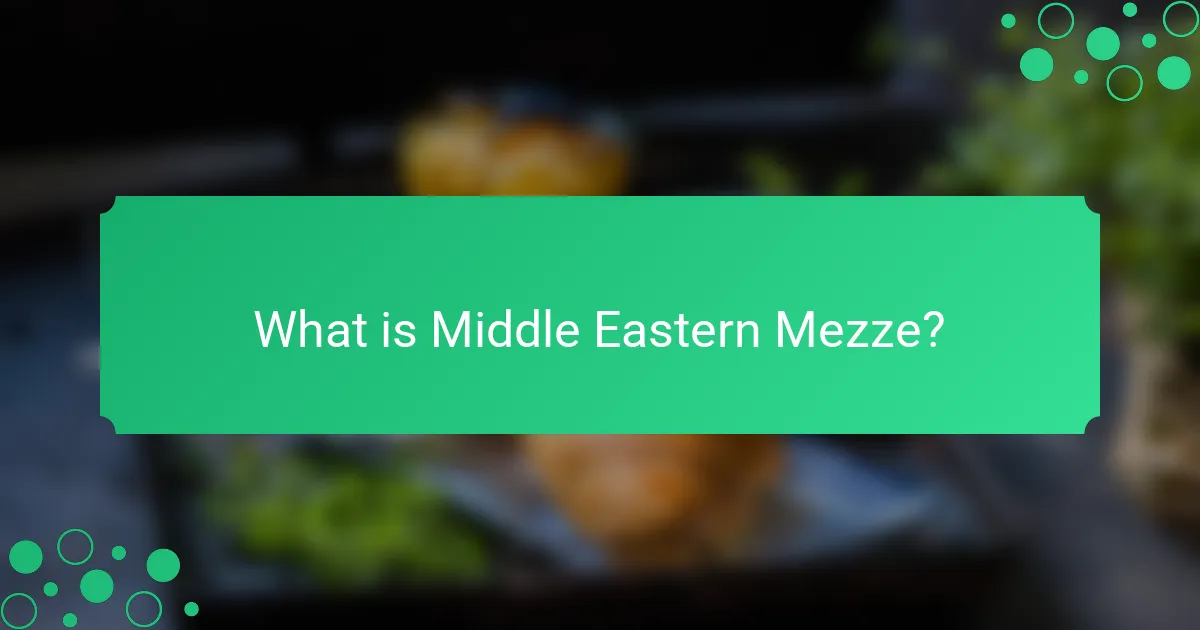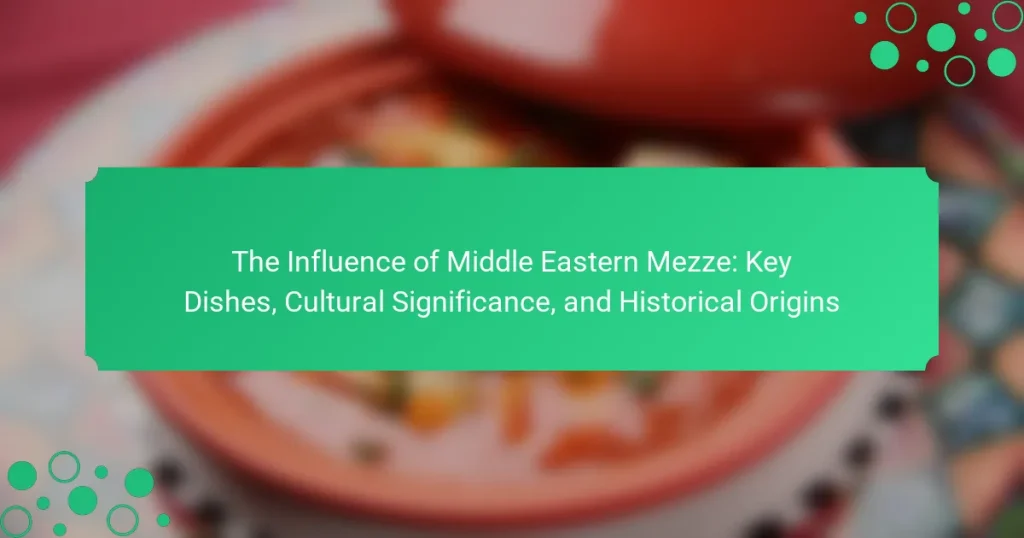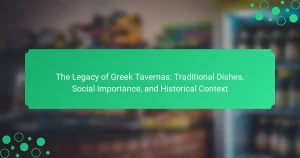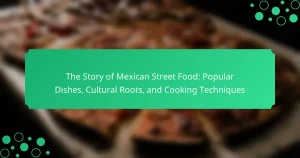Middle Eastern mezze is a collection of small dishes traditionally served as appetizers, fostering communal dining and social interaction. Key mezze dishes include hummus, baba ghanoush, tabbouleh, falafel, and dolmas, each showcasing the rich flavors and ingredients of Middle Eastern cuisine. Originating from the Levant region, mezze has become a staple in cultural celebrations and gatherings, influencing contemporary dining trends with its emphasis on sharing and diverse flavors. This article explores the significance of mezze, its historical roots, and its impact on modern culinary practices, highlighting its role in enhancing social connections through food.

What is Middle Eastern Mezze?
Middle Eastern mezze refers to a variety of small dishes served as appetizers. These dishes are commonly enjoyed in social settings. Mezze can include items like hummus, baba ghanoush, tabbouleh, and stuffed grape leaves. This culinary tradition promotes sharing and communal dining. Mezze is often accompanied by pita bread and various dips. The concept has roots in the Levant region, which includes countries like Lebanon and Syria. Mezze reflects the rich flavors and ingredients of Middle Eastern cuisine. It is a staple in many cultural celebrations and gatherings.
How did Middle Eastern Mezze originate?
Middle Eastern mezze originated as a communal dining tradition. It reflects the region’s emphasis on hospitality and sharing. Traditionally, mezze consists of small dishes served before the main course. Historical evidence shows that this practice dates back to ancient civilizations in the Middle East. The variety of ingredients used in mezze highlights the agricultural diversity of the region. Common ingredients include vegetables, legumes, and spices, which are staples in Middle Eastern cuisine. The social aspect of mezze encourages interaction among diners. As trade routes expanded, influences from various cultures enriched mezze offerings. This resulted in a rich tapestry of flavors and dishes that characterize modern mezze.
What historical influences shaped the development of Mezze?
Mezze developed from various historical influences, including trade, cultural exchanges, and regional cuisines. The Silk Road facilitated the movement of spices and ingredients, enriching local dishes. Ottoman Empire expansion introduced diverse culinary practices across regions. Mediterranean cultures contributed to the variety of mezze offerings, incorporating vegetables, grains, and meats. Social dining customs in Middle Eastern societies emphasized shared plates, promoting communal eating. Historical texts, such as those from ancient Persia, reference similar dining styles, highlighting mezze’s long-standing tradition. These influences collectively shaped mezze into a vibrant and diverse culinary experience.
Which regions contributed to the evolution of Mezze dishes?
The regions that contributed to the evolution of Mezze dishes include the Levant, Anatolia, and North Africa. The Levant, which encompasses countries like Lebanon, Syria, and Jordan, is known for its diverse Mezze offerings. Anatolia, primarily in Turkey, introduced various flavors and cooking techniques to Mezze. North Africa, particularly Morocco and Tunisia, added unique spices and ingredients to the Mezze repertoire. Each of these regions has distinct culinary traditions that shaped Mezze dishes over time. Historical trade routes facilitated the exchange of ingredients and cooking methods, further influencing Mezze evolution.
What are the key components of Middle Eastern Mezze?
Middle Eastern Mezze consists of a variety of small dishes served as appetizers. Common components include hummus, baba ghanoush, tabbouleh, and falafel. Hummus is a creamy dip made from chickpeas and tahini. Baba ghanoush features roasted eggplant blended with tahini and spices. Tabbouleh is a fresh salad made with parsley, tomatoes, and bulgur wheat. Falafel are deep-fried balls made from ground chickpeas or fava beans. Other components may include olives, pickles, and various dips. Mezze is traditionally served with pita bread. This style of dining encourages sharing and social interaction.
What types of ingredients are commonly used in Mezze?
Mezze commonly includes a variety of ingredients such as vegetables, legumes, grains, and meats. Fresh vegetables like cucumbers, tomatoes, and bell peppers are frequently used. Legumes include chickpeas and lentils, often featured in dishes like hummus and mujaddara. Grains such as bulgur and rice are also common. Additionally, various meats, including lamb and chicken, may be included in certain mezze dishes. Herbs and spices like parsley, mint, and cumin enhance the flavors. Olive oil and yogurt are often used as accompaniments. These ingredients reflect the diverse culinary traditions of the Middle East.
How are Mezze dishes typically prepared and served?
Mezze dishes are typically prepared by assembling a variety of small, flavorful dishes. These dishes often include dips, salads, and finger foods. Common ingredients are vegetables, legumes, meats, and spices. Preparation methods vary and may include grilling, frying, or marinating.
Mezze is usually served in a communal style, encouraging sharing among diners. The dishes are often presented on large platters or in small bowls. Accompaniments like bread, olives, and pickles are common. Mezze is traditionally enjoyed with drinks, often in social settings. This style of dining reflects the cultural significance of hospitality in Middle Eastern traditions.
Why is Mezze significant in Middle Eastern culture?
Mezze is significant in Middle Eastern culture as it represents communal dining and hospitality. This style of serving multiple small dishes encourages sharing and interaction among guests. Mezze includes a variety of flavors and textures, showcasing the region’s culinary diversity. Traditionally, it is served during gatherings and celebrations, symbolizing generosity. The practice of mezze dates back centuries, reflecting historical trade routes and cultural exchanges. It often features ingredients like olives, hummus, and tabbouleh, which are staples in Middle Eastern diets. This communal approach fosters social bonds and cultural identity within communities. Overall, mezze is more than just food; it embodies cultural values and traditions in the Middle East.
How does Mezze reflect social customs and traditions?
Mezze reflects social customs and traditions by serving as a communal dining experience. This style of eating encourages sharing and interaction among participants. Traditionally, mezze is enjoyed during gatherings, celebrations, and family meals. It showcases a variety of dishes, symbolizing hospitality in Middle Eastern cultures. The preparation and presentation of mezze often involve family recipes passed down through generations. This highlights the importance of cultural heritage and identity. Furthermore, the variety of flavors and ingredients represents regional diversity and local customs. Overall, mezze embodies the values of community, sharing, and cultural continuity in social settings.
What role does Mezze play in communal dining experiences?
Mezze plays a central role in communal dining experiences by promoting sharing and interaction among diners. This style of dining encourages people to sample a variety of dishes together. Mezze typically consists of small plates, allowing for diverse flavors and textures. The act of sharing these plates fosters a sense of community and connection. Historically, mezze has been integral to Middle Eastern culture, enhancing social bonds during meals. It often accompanies celebrations and gatherings, reinforcing its significance. Studies show that communal meals, like those featuring mezze, enhance social cohesion and enjoyment.

What are the most popular Mezze dishes?
The most popular Mezze dishes include Hummus, Baba Ghanoush, Tabbouleh, Falafel, and Dolmas. Hummus is a creamy dip made from chickpeas, tahini, lemon juice, and garlic. Baba Ghanoush features roasted eggplant blended with tahini and spices. Tabbouleh is a fresh salad primarily made of parsley, mint, tomatoes, and bulgur wheat. Falafel consists of deep-fried balls made from ground chickpeas or fava beans. Dolmas are grape leaves stuffed with rice, pine nuts, and herbs. These dishes are staples in Middle Eastern cuisine and are enjoyed for their flavors and textures. They often serve as appetizers or side dishes in social gatherings.
Which Mezze dishes are considered staples?
Staple mezze dishes include hummus, baba ghanoush, tabbouleh, and falafel. Hummus is a chickpea dip blended with tahini, olive oil, and lemon juice. Baba ghanoush features roasted eggplant mixed with tahini and garlic. Tabbouleh is a fresh salad made primarily of parsley, bulgur, tomatoes, and mint. Falafel consists of deep-fried chickpea balls, often served with tahini sauce. These dishes are commonly found in Middle Eastern cuisine and are enjoyed in various cultures. Their popularity stems from their flavors and nutritional benefits.
What are the ingredients and preparation methods for Hummus?
Hummus is a Middle Eastern dip made primarily from chickpeas. Key ingredients include cooked chickpeas, tahini, olive oil, lemon juice, garlic, and salt. To prepare hummus, start by blending the chickpeas, tahini, and garlic in a food processor. Gradually add olive oil and lemon juice while blending until smooth. Adjust the texture with water if necessary. Season with salt to taste. Serve with a drizzle of olive oil on top. This method creates a creamy and flavorful hummus, which is a staple in Middle Eastern cuisine.
How is Baba Ganoush made and served?
Baba Ganoush is made by roasting eggplants until the skin is charred. After roasting, the eggplants are peeled and the flesh is scooped out. The flesh is then blended with tahini, garlic, lemon juice, and olive oil. Salt and pepper are added to taste. This mixture is served chilled or at room temperature. Baba Ganoush is typically garnished with olive oil, parsley, or pomegranate seeds. It is served as a dip with pita bread or fresh vegetables. This dish is a staple in Middle Eastern cuisine and is often part of a mezze platter.
What variations exist among different cultures’ Mezze?
Variations among different cultures’ Mezze include distinct dishes and preparation styles. Mediterranean mezze often features items like hummus, tabbouleh, and baba ghanoush. In Lebanese cuisine, mezze may include grilled meats and pickled vegetables. Turkish mezze typically showcases a variety of cheeses and seafood dishes. Greek mezze often incorporates olives, tzatziki, and spanakopita. Each culture emphasizes local ingredients and flavors. For example, Persian mezze includes dishes like kashk-e bademjan, a type of eggplant dip. The diversity reflects regional agricultural practices and culinary traditions. These variations highlight the cultural significance of mezze in social gatherings and celebrations.
How do Turkish Mezze differ from Lebanese Mezze?
Turkish mezze differ from Lebanese mezze primarily in their flavor profiles and ingredient choices. Turkish mezze often feature grilled meats, yogurt-based dishes, and a variety of spices like sumac and paprika. Common examples include kebabs, haydari (yogurt with herbs), and muhammara (pepper and walnut dip).
In contrast, Lebanese mezze emphasize fresh vegetables, legumes, and herbs, often showcasing dishes like tabbouleh, baba ghanoush, and hummus. Lebanese mezze tend to have a lighter, fresher taste due to the abundant use of parsley, mint, and lemon.
The presentation also varies; Turkish mezze may be served warm, while Lebanese mezze are typically served cold or at room temperature. Both cuisines reflect their cultural heritage, with Turkish mezze influenced by Ottoman traditions and Lebanese mezze drawing from a Mediterranean background.
What unique dishes are found in Persian Mezze?
Persian Mezze includes unique dishes such as Mirza Ghasemi, Kashk-e Bademjan, and Dolmeh. Mirza Ghasemi is a smoky eggplant dish with tomatoes and garlic. Kashk-e Bademjan combines sautéed eggplant with kashk, a fermented whey, and spices. Dolmeh consists of grape leaves stuffed with rice, herbs, and sometimes meat. These dishes reflect the rich culinary traditions of Iran. Each dish highlights the use of fresh ingredients and aromatic spices. Persian Mezze is often served with flatbreads and yogurt. Together, these elements create a diverse and flavorful dining experience.

How does Mezze influence culinary practices today?
Mezze influences culinary practices today by promoting sharing and communal dining experiences. This style encourages a variety of small dishes, allowing for diverse flavors in one meal. Restaurants and home cooks alike adopt mezze to enhance social interactions during meals. The concept of mezze has spread beyond Middle Eastern cuisine, influencing Mediterranean and even Western dining trends. This shift reflects a growing preference for tapas-style dining and small plates in contemporary gastronomy. Research indicates that communal meals foster connections, making mezze a popular choice for gatherings. The emphasis on fresh ingredients and bold flavors in mezze also inspires modern culinary creativity.
What trends are emerging in the presentation of Mezze?
Emerging trends in the presentation of Mezze include artistic plating and interactive dining experiences. Chefs are focusing on vibrant colors and textures to enhance visual appeal. Seasonal ingredients are being prioritized to reflect freshness and locality. Small, shareable portions are becoming more common, promoting communal eating. There is a rise in plant-based options catering to dietary preferences. Traditional presentations are being modernized with contemporary serving ware. Lastly, cultural storytelling is integrated into the presentation to enhance the dining experience. These trends reflect a growing emphasis on aesthetics, sustainability, and cultural connection in Mezze dining.
How are modern chefs reinterpreting traditional Mezze dishes?
Modern chefs are reinterpreting traditional Mezze dishes by incorporating contemporary ingredients and techniques. They are blending flavors from different cuisines to create innovative variations. For example, traditional hummus is now made with unusual ingredients like beetroot or avocado. Chefs are also presenting Mezze in modern plating styles, elevating the visual appeal. Additionally, they are focusing on plant-based versions to cater to dietary preferences. This approach maintains the essence of Mezze while appealing to a broader audience. The shift reflects a growing trend in culinary creativity and cultural fusion.
What fusion cuisines incorporate Mezze elements?
Mediterranean fusion cuisine incorporates Mezze elements. This cuisine blends traditional dishes from various Mediterranean cultures. It often includes small plates like hummus, baba ghanoush, and tabbouleh. Asian fusion cuisine also embraces Mezze concepts. Dishes may feature small shared plates inspired by Middle Eastern flavors. Additionally, modern American cuisine frequently adopts Mezze elements. Restaurants may offer Mezze platters as appetizers. These culinary trends highlight the versatility of Mezze across different cultural contexts.
What tips can enhance the Mezze dining experience?
To enhance the Mezze dining experience, consider sharing a variety of dishes. Mezze is best enjoyed communally, allowing for a diverse tasting experience. Include both hot and cold dishes to create contrast in flavors and temperatures. Pair Mezze with traditional beverages like arak or mint tea for authentic enjoyment. Use fresh, high-quality ingredients to elevate the flavors of each dish. Incorporate a mix of textures, such as crunchy vegetables and creamy dips, to enhance the sensory experience. Serve Mezze on large platters to encourage social interaction and sharing. Finally, take time to savor each dish, as Mezze is meant to be a leisurely dining experience.
How should Mezze be paired with beverages for optimal enjoyment?
Mezze should be paired with beverages that complement their diverse flavors. White wines, particularly dry varieties, enhance the freshness of dishes like tabbouleh and hummus. Sparkling water or lemonade can provide a refreshing contrast to richer items like baba ghanoush. Traditional Middle Eastern beverages, such as ayran or mint tea, also pair well, balancing the spices in the mezze. Beer, especially light lagers, can match the saltiness of olives and cheeses. Each beverage choice can elevate the overall dining experience by harmonizing with mezze’s varied textures and tastes.
What are some best practices for hosting a Mezze-themed gathering?
To host a Mezze-themed gathering, ensure a variety of dishes are prepared. Include dips like hummus and baba ghanoush. Offer a selection of breads such as pita and lavash. Incorporate fresh vegetables like cucumbers and tomatoes for dipping. Serve a mix of proteins, including falafel and grilled meats. Arrange the dishes on a large table for communal sharing. Provide plenty of small plates and utensils for guests. Consider pairing the meal with traditional beverages like mint tea or arak. These practices create an authentic and enjoyable Mezze experience.
Middle Eastern mezze is a culinary tradition characterized by a variety of small dishes served as appetizers, promoting communal dining and social interaction. This article explores the origins of mezze, tracing its historical influences from ancient civilizations and trade routes, as well as its evolution across regions such as the Levant, Anatolia, and North Africa. Key components of mezze, including popular dishes like hummus, baba ghanoush, and tabbouleh, are highlighted, along with preparation methods and cultural significance. Additionally, the article examines contemporary trends in mezze presentation and its influence on modern culinary practices, emphasizing the importance of shared dining experiences in Middle Eastern culture.




